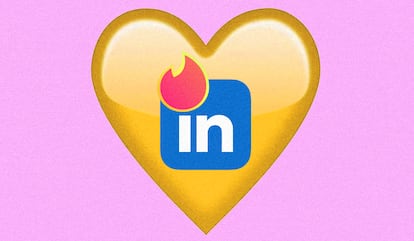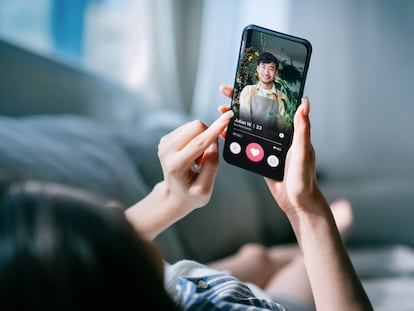When Tinder and LinkedIn overlap: More and more people are looking for work on dating apps
As users expand their horizons, the platforms are beginning to resemble each other


A study from last August of about 1,000 active LinkedIn users concluded that 91% have received inappropriate messages or flirting attempts at least once. 31% of those messages were explicit propositions of sexual or romantic encounters. The platform claims to be completely against this behavior. “LinkedIn is a professional community, and we encourage our members to have meaningful and authentic conversations,” reads a statement from the company. “That includes light-hearted content, as long as it remains professional and does not infringe on our policies for the professional community. Romantic insinuations and any kind of harassment are a violation of our norms.”
Experts in relationships discourage mixing the uses of the different applications. Those made for work are meant for work. “Of course, it isn’t ideal, and, in fact, we could argue that it’s counterproductive. Applications, especially dating apps, are more and more specialized, so this kind of behavior doesn’t make sense,” says Silvia Rúbies, head of communication at Gleeden. Regarding the increasing specialization, Gleeden is a good example: it is a platform that brings together married people who are seeking an adventure.
Experts emphasize that using work platforms to flirt is a bad idea, but what if we turn the formula around? It’s more and more common to use dating apps to find work. According to Business Insider, a quarter of Grindr users use the platform to network. And the company does not only encourage it, but uses the method for its own workforce: Grindr’s executive director told The Wall Street Journal that, over the years, he has hired people he met on the app.
Tinder, on the other hand, insists that its platform is uncomfortable with such behavior. “Tinder advises always being sincere and acting honestly. If there’s anything members of the application don’t want, it’s runarounds and misunderstandings. Our advice for our members who seek any kind of interaction is to express what they want directly and honestly. Transparency and authenticity are indispensable when it comes to matching on Tinder, as well as knowing that your possible date is on the same page as you are,” the company says.
The professional match
Victor G., a community manager for a fashion brand, found a man on Raya so impressive that he questioned why he had responded to him. “He was extremely handsome, so much so that I joked with my friends that he was made by artificial intelligence. He was from Galicia and he had just moved to Barcelona, where he was looking for work while he did some freelance projects. We work in the same sector, so we talked a lot about that. I prepared a special date for a Thursday and that day, when I spoke with him in the morning to confirm, he disappeared. He ghosted me, and I realized he was looking for work contacts, not dates,” he says.
Silvia Rúbies emphasizes that looking for a job on a dating app is both absurd and unprofessional. “To find what you want through cyberspace, the best thing to do is use applications and platforms made expressly for that purpose. That way no one wastes their time, nothing is hidden and the possibilities of success are much higher,” she says. Alba Durán from Bumble agrees that if someone is interested in another for merely professional reasons, they should make it clear from the beginning. “Our mission is to create a respectful, friendly space for dates, and for that to happen, it’s important for us to help people identify and talk about their intentions. To do so, we have functions that allow members to see shared interests and things in common from the start,” she explains.
The platform Shape is proof that dating apps have changed everything. Its interface is similar to that of Tinder: users can swipe their way to their dream jobs. While LinkedIn recommends connections with people that you already follow, dating apps use statistical models based on artificial intelligence to suggest opportunities according to the requirements of the job-seeker or hiring manager. For that reason, Shape’s setup resembles a dating application more than a job portal. It’s not just that users are mixing the uses of applications. Apps themselves are evolving in a Tinderization of the job market.
Sign up for our weekly newsletter to get more English-language news coverage from EL PAÍS USA Edition
Tu suscripción se está usando en otro dispositivo
¿Quieres añadir otro usuario a tu suscripción?
Si continúas leyendo en este dispositivo, no se podrá leer en el otro.
FlechaTu suscripción se está usando en otro dispositivo y solo puedes acceder a EL PAÍS desde un dispositivo a la vez.
Si quieres compartir tu cuenta, cambia tu suscripción a la modalidad Premium, así podrás añadir otro usuario. Cada uno accederá con su propia cuenta de email, lo que os permitirá personalizar vuestra experiencia en EL PAÍS.
¿Tienes una suscripción de empresa? Accede aquí para contratar más cuentas.
En el caso de no saber quién está usando tu cuenta, te recomendamos cambiar tu contraseña aquí.
Si decides continuar compartiendo tu cuenta, este mensaje se mostrará en tu dispositivo y en el de la otra persona que está usando tu cuenta de forma indefinida, afectando a tu experiencia de lectura. Puedes consultar aquí los términos y condiciones de la suscripción digital.
More information
Archived In
Últimas noticias
Most viewed
- Sinaloa Cartel war is taking its toll on Los Chapitos
- Oona Chaplin: ‘I told James Cameron that I was living in a treehouse and starting a permaculture project with a friend’
- Reinhard Genzel, Nobel laureate in physics: ‘One-minute videos will never give you the truth’
- Why the price of coffee has skyrocketed: from Brazilian plantations to specialty coffee houses
- Silver prices are going crazy: This is what’s fueling the rally










































